Featured image: SpaceX
Liftoff Time | February 15, 2024 – 06:05:37 UTC | 01:05:37 EST |
|---|---|
Mission Name | IM-1 (Intuitive Machines mission 1), Nova-C “Odysseus” |
Launch Provider | SpaceX |
Customer | Intuitive Machines NASA Others |
Rocket | Falcon 9 Block 5, booster B1060-18, 144.10-day turnaround time |
Launch Location | Launch Complex 39A (LC-39A), Kennedy Space Center, Florida, USA |
Payload mass | 1,931 kg (~4,260 lb) |
Where did the spacecraft go? | Trans-lunar injection (TLI), and finally the Malapert A crater, very close to the lunar south pole |
Did they attempt to recover the first stage? | Yes |
Where did the first stage land? | The booster softly touched down on Landing Zone 1 (LZ-1) |
Did they attempt to recover the fairings? | Yes, and they were recovered from the water ~595 km downrange by vessel Bob |
Were these fairings new? | TBD, but SpaceX usually flies reused fairing halves |
This was the: | – 1st launch toward the Moon from LC-39A since Apollo 17 in 1972 – 299th Falcon 9 launch – 230th Falcon 9 flight with a flight-proven booster – 244th reflight of a booster – 13th reflight of a booster in 2024 – 273rd booster landing – 199th consecutive landing (a record) – 14th launch for SpaceX in 2024 – 75th SpaceX launch from LC-39A – 30th orbital launch attempt of 2024 |
Where to re-watch | NASA’s official launch replay on Youtube SpaceX’s official launch replay on X Intuitive Machine’s official landing replay on Youtube NASA’s official landing replay on Youtube NASA’s official post-landing conference replay on Youtube |
What’s All This Mean?
Intuitive Machines’ lunar lander, Nova-C, performs the IM-1 mission in the frame of a CLPS NASA contract. It launches aboard SpaceX’s Falcon 9 rocket, lifting off from historical Launch Complex 39A (LC-39A), at John F. Kennedy Space Center, Florida. It will head due east. Following stage separation, and as a secondary objective, Falcon 9’s booster should return for a touchdown on Landing Zone 1.
Once the lander is deployed from the launch vehicle, it will find itself in an orbit known as trans-lunar injection (TLI). That is, its trajectory will take it to the Moon, though some fine-tuning burns are expected. After several days journeying through space, its lunar orbit insertion should take place. Afterward, the itinerary includes its descent onto the surface, where it will carry out many observations during seven days, hopefully more.
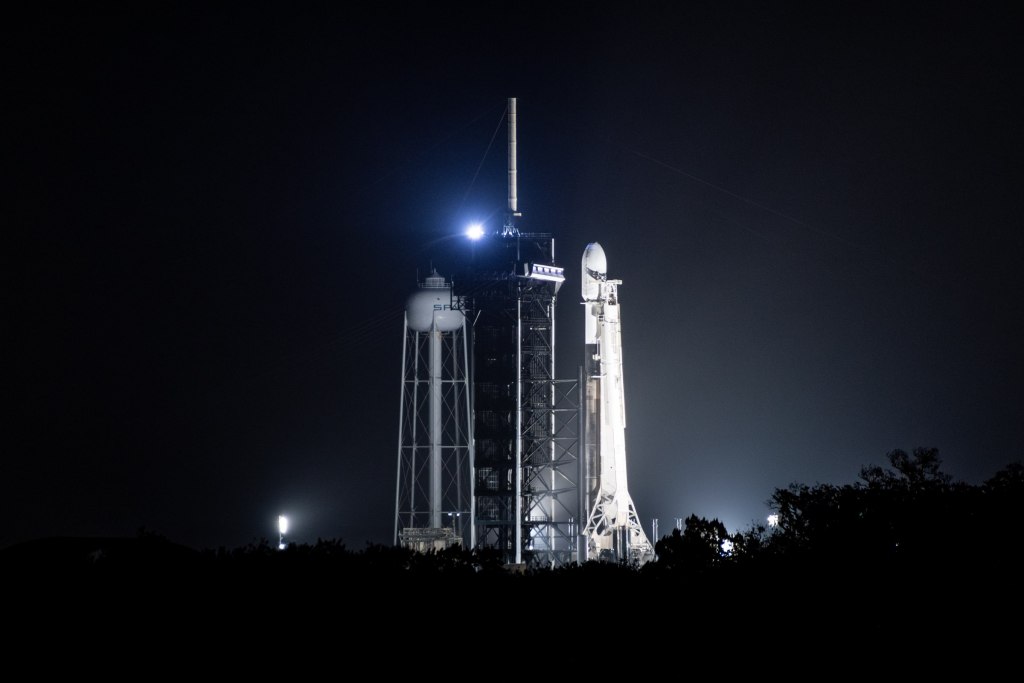
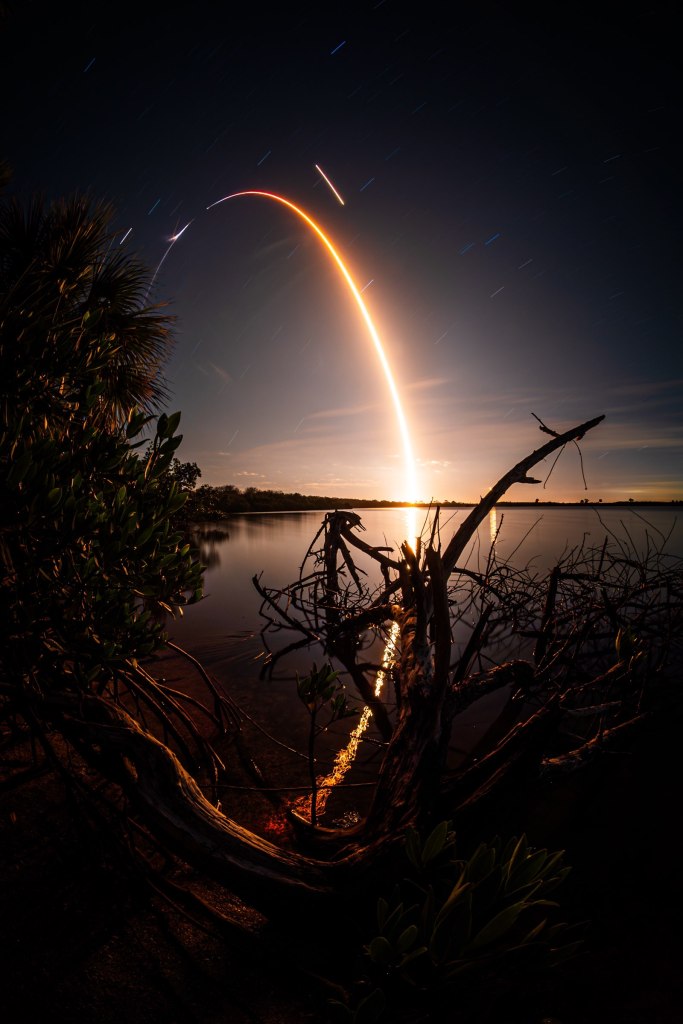
How Did It Go?
SpaceX carried out the countdown to IM-1’s launch, and the Falcon 9 lifted off into the darkness of the night, illuminating the skies. Throughout the flight, step after step everything turned out nominal, including the lander’s deployment by the second stage. The first stage had previously returned to the Space Coast, and successfully come to rest on LZ-1. Consequently, the launch side of the mission closed out with a full success.
On the other hand, Nova-C Odysseus found itself on the way to the Moon, a journey that would take approximately six days. This considered only the time before the spacecraft would perform its insertion into lunar orbit, while another two days would pass before the landing was scheduled.
On February 22, at 23:24 UTC, Intuitive Machines’ lander, Odysseus, successfully performed its landing. Congratulations to every team involved in this project, and in achieving this great feat! The next few days before the lunar sunset will be packed full of activity for many of the payloads carried by this Nova-C. Hopefully, the teams will learn even more, and hit further milestones.
What Is IM-1, Nova-C Odysseus?
Belonging to the CLPS initiative, Intuitive Machines mission 1, or IM-1 for short, represents many potential and actual firsts for this kind of mission. First, it showcases the maiden flight of the company’s lunar lander: Nova-C, the first such spacecraft powered by cryogenic propellants. The second key point arises from its chance to become the first US lander to softly touch down on the surface of the Moon since the last Apollo mission in 1972.
In order to better comprehend IM-1, where it comes from, and what it will be doing, additional context comes in handy. For example, an introduction to its relation to NASA, or even some information about the company executing it. We offer this in the following subsections, finally diving deep into the present mission itself.
Commercial Lunar Payload Services (CLPS)
NASA proposed back in 2018 an initiative that would attempt to foster future Moon-related operations. That is, a series of commercial contractors selected by the agency would receive orders to fly payloads to our natural satellite. Though NASA would provide many of them, it also encourages the transportation of private payloads. It is important to realize that these payloads have to share the common goal of developing capabilities for science, exploration, or commercial development on the Moon.
Initially, a first group of companies became part of the initiative on November 29, 2018:
- Astrobotic Technology, Inc.: Pittsburgh
- Deep Space Systems: Littleton, Colorado (parent: Redwire Space)
- Draper: Cambridge, Massachusetts
- Firefly Aerospace, Inc.: Cedar Park, Texas
- Intuitive Machines, LLC: Houston
- Lockheed Martin Space: Littleton, Colorado
- Masten Space Systems, Inc.: Mojave, California (later acquired by Astrobotic Technology)
- Moon Express: Cape Canaveral, Florida
- Orbit Beyond: Edison, New Jersey
Then, on November 18, 2019, a second group joined the first one:
- Blue Origin: Kent, Washington
- Ceres Robotics: Palo Alto, California
- Sierra Nevada Corporation: Louisville, Colorado
- SpaceX: Hawthorne, California
- Tyvak Nano-Satellite Systems Inc.: Irvine, California (later acquired by Terran Orbital Corporation)
In addition to NASA payloads, companies are also encouraged to fly commercial payloads. When the agency, or a commercial client, contracts one of these companies for lunar delivery, the latter takes responsibility for:
- payload integration,
- mission operations,
- launch from Earth, and
- landing on the surface of the Moon.
Additionally, it is worth noting that to complete their tasks, contractors can, in turn, subcontract third parties.
Intuitive Machines
The Houston, Texas-based firm was founded in 2013 by Steve Altemus (CEO), Dr. Timothy P. Crain (CTO), and Kam Ghaffarian. The first two co-founders brought with them valuable expertise gained during their successful careers at NASA’s Johnson Space Center. In contrast, Ghaffarian contributed his extensive experience from the private aerospace sector.
As Intuitive Machine states on its website, human motivation chiefly stems from different sources, ultimately leading to the betterment of humanity as a whole. In fact, this is precisely what the company intends to achieve: overcome some our species’ greatest challenges. Particularly, Intuitive Machine plans to do so through its lunar program, which should enable:
- lunar surface access,
- lunar orbit delivery, and
- communications at lunar distance.
Presently, the company has three CLPS contracts in its pocket, and at different stages of completion. That is, after the first mission, IM-2 will take the NASA-funded Polar Resources Ice-Mining Experiment-1 (PRIME-1), a lunar ice drill, to the Moon. The following one is IM-3, completing the list, and aiming at studying Reinier Gamma: a prominent lunar swirl. These will take place, however, most certainly later than June 2024.
Intuitive Machines Mission 1, Or IM-1
The first flight of the Houston-based firm has its lander headed toward our Moon. Known as Nova-C, this name falls under a category designation, with “Nova” meaning new, and “C” being the Roman numeral for 100. In other words, Intuitive Machines designates their landers with a capability of transporting about 100 kg to the surface of the Moon using this naming convention. On the other hand, the specific vehicle performing this mission is named Odysseus, or Odie, inspired by the Greek epic poem, the Iliad.
Moreover, Odie’s destination on the Moon is the Malapert A crater, where it will conduct its tasks. The company expects its lander to be active for seven days, after which the lunar night will force it to shut down. If it wakes up again, it will collect more data for a short period of time. This is improbable, however, given that its design did not consider surviving said period of intense cold.
Nova-C, The Spacecraft
In terms of specifications, the lander measures 2.2×2.4×3.9 m (~7.2×7.9×13 ft), featuring mass at launch of 1,931 kg (~4,260 lb). However, when not considering propellants and fluids, its mass is only 655 kg (~1,440 lb). Carbon fiber and titanium account for most of that value, being the main materials used in its manufacturing. These form its hexagonal structure, as well as the propellant tanks.
Propulsion
Its main propulsion system consists of a single VR900 engine that runs on liquid methane (LCH4), and liquid oxygen (LOx). As a result, this makes of Nova-C a unique case among lunar landers. In a word, never before has this kind of spacecraft implemented methalox-fed engines, or any cryogenic propellant, for that matter. Accordingly, the lander’s tanks need to be filled just before liftoff. In turn, this requirement drove SpaceX to incorporate a new system into its transporter-erector.
In order to control Nova-C’s orientation, cold gas thrusters utilize gaseous helium (GHe) stored inside two composite tanks. The gas exits through an array of nozzles, which feature redundancy to enhance safety. Helium also serves the purpose of pressurizing both the methane and the oxygen tanks.
At launch, the maximum mass for each propellant will amount to:
- LCH4: 839 kg (~1,850 lb)
- LOx: 420 kg (~930 lb)
- GHe: 17 kg (~37 lb)
Through the use of the RCS thrusters, Odie can enter the following modes:
- Solar pointing mode, for power generation, with the top deck facing the sun.
- Propulsion vector tracking mode, for burns, pointing as needed.
- Communications HGA tracking mode, for high-rate communications, pointing the high-gain antennas to Earth.
Electrical Power
Nova-C generates electrical power by means of photovoltaic cells arranged in three solar panels. These consist of a large top deck panel, as well as two smaller body panels. As a result, Odie produces a maximum of 788 W of electricity, depending on its attitude, or other factors. Given that power demand varies along the mission, three commercial off-the-shelf lithium-ion batteries store it. Conversely, they supply the spacecraft with power when generation dwindles, or does not match consumption. Finally, a power distribution units manages all of these conditions.
NASA Payloads
As has been noted, on Odysseus travels a total of six NASA payloads. Most of these devices are installed on the outside of the spacecraft, as you can see in the previous image.
ROLSES
This experiment’s name is Radio Observations of the Lunar Surface Photoelectron Sheath, with Goddard Space Flight Center being in charge of its development. Given that the Moon does not benefit from an atmosphere to protect its surface, nothing stops radiation from hitting it. Therefore, an interaction with lunar dust occurs, which needs consideration when designing future space suits, rovers, and equipment. Using its four antennas, ROLSES will measure radio waves from many sources, like the Sun, deep space, and even our own planet. It features a total mass of 13.1 kg (~29 lb). More about ROLSES on this NASA article.
LRA
The Laser Retro-Reflector Array is a tiny device, massing at only 0.02 kg (~0.04 lb), and measuring just 1.65×5.10 cm (~0.65×2.00 in). It was also developed by Goddard Space Flight Center, with the purpose to serve for guidance. Because it is an array of eight mirrors, a spacecraft could shoot a laser beam at it, and receive a reflection. As a result, the reflection would enable the spacecraft determine where it is. A practical implementation could be during Artemis missions during descent, using LRAs on the surface. Read more about LRA on this NASA article.
NDL
Langley Research Center designed the Navigation Doppler Lidar for Precise Velocity and Range Sensing, or NDL for short. With quite a self-explanatory name, it functions similarly to radar, though it uses light instead of radio waves. By means of this device, spacecraft could measure their distance to the ground, and how fast they move. It consists of three small telescopes coupled with the appropriate electronics. The NDL roughly measures 14x29x40 cm (~6x11x16 in), while massing at 15 kg (~33 lb). Read more about this on its NASA article.
SCALPSS
Another payload by Langley Research Center: the Stereo Cameras for Lunar Plume-Surface Studies. The idea behind this 6 kg (~13 lb) device points at improving the safety of future landers during the last instants of descent. As a matter of fact, SCALPSS will utilize four cameras to record footage of Nova-C engine’s exhaust interacting with the lunar regolith. Consequently, better predictive models could be developed, reducing the risk of damaging a spacecraft while it tries to touch down on the Moon. To know more, read this NASA article.
RFMG
In another NASA payload, Glen Research Center provides the Radio Frequency Mass Gauge statement. By utilizing antennas inside each tank, its task is to determine propellant’s levels. Accurately measuring them should increase mission’s efficiency, particularly regarding the utilization of consumables. Taking its electronics inside a 15x20x20 cm (~6x8x8 in) box, together with all of its antennas into consideration, RFMG has a mass of 2 kg (~4 lb). Read more about this instrument on this NASA article.
LN-1
Marshall Space Flight Center sends the Lunar Node 1 navigation demonstrator. Featuring a mass of 3 kg (~7 lb), as well as measuring 11x22x33 cm (~4x9x13 in), it will function as a beacon. Further, LN-1-like devices should help to guide spacecraft arriving or leaving the Moon by using S-band radio waves. This time, however, the demonstrator will only emit signals that NASA’s Deep Space Network will use to obtain precise positioning. More about LN-1 on this NASA article.
Commercial Payloads
Columbia Sportswear
Omni-Heat Infinity, an innovative material developed by Columbia, shows promising characteristics as thermal protection. Specifically tailored to increase reflectivity, Intuitive Machines applied it on an external panel. Given that Nova-C’s tanks storing cryogenic propellants need to remain within a certain range of temperatures, the material is expected to help them reach the goal. Read more about it on Columbia’s Omni-Heat page.
Embry-Riddle Eaglecam
Steve Altemus, formerly an attendee at Embry-Riddle, challenged its students to envision a way of taking pictures of IM-1’s landing. That is, the image has to be taken from a third person perspective. In response, they created a camera that will jump from the spacecraft at a 30 m (~100 ft) altitude above the Moon’s surface. While testing an electrostatic dust-removal system, it will attempt to capture the touch down for posterity. Read more about it on Embry-Riddle’s Eaglecam page.
Jeff Koons: Moon Phases
125 miniature steel Moon Phases sculptures will fly on the side of Odysseus via 4Space, later to be displayed on our natural satellite. The artwork actually consists of three parts, as for each sculpture, another one remains on Earth. Additionally, a non-fungible token connects both of them. The names of individuals who achieved a variety of accomplishments in various fields are inscribed in front of each art piece. Read more on Moon Phases’ website.
International Lunar Observatory Association: ILO-X
As a demonstrator in preparation for the Moon South Pole Observatory, ILO-1, two small cameras fly this time for the association. Their main goal is to take the first images of the center of our galaxy from the Moon. Additionally, the ~0.6 kg (~1.3 lb) ILO-X suite will carry out astronomical, lunar, and Earth observations. ILOA expects it to undergo further validations, like surviving the environment on our natural satellite. Read more on the association’s page on ILO-X.
Lonestar Data Holdings Inc.
The Independence payload demonstrates Lonestar’s Disaster Recovery as a Service (DRaaS) technology, utilizing the unique properties of the Moon. In fact, the mission is to send a technology demonstrator to the Moon for secure premium data storage and edge processing. Together with Intuitive Machines, they will store and transmit digital data to and from the Moon. This will pave the way for their larger data center payload, Freedom, on their following lunar mission. Read more about it on Lonestar’s site.
Gallactic Legacy Labs: Lunaprise
With a collection of messages called Lunagrams, Galactic & partners pursue the overall goal of preserving human knowledge for eternity. That is, Lunaprise will keep text, images, music, and video well preserved. The English Wikipedia, or the Rosetta Project are examples to illustrate the kind of content stored inside this time capsule. Read more about Lunaprise on this website.
Odysseus Journey
Once the second stage of the Falcon 9 deploys the lander, its orbit will feature an apogee, highest point of the orbit, that will allow for lunar interception. The remaining orbital parameters include a perigee of about 185 km (~115 mi), meanwhile its inclination will be 27 degrees. Should Odysseus fail, a fly-by past the Moon will sling-shot the spacecraft into an orbit around the Sun.
As per Intuitive Machines, the journey from the Earth to the Moon will include the milestones in the following list:
- Launch
- Launch Vehicle Separation
- Autonomous Commissioning
- Engine Commissioning
- Trajectory Correction Maneuvers 1, 2, & 3
- Maneuver to Lunar Orbit Insertion Attitude
- Lunar Orbit Insertion
- Low Lunar Orbit, at 100 km (~60 mi) above our moon’s surface
- Descent Orbit Insertion
- Terrain Relative Navigation
- Powered Descent Initiation
- Pitch Over with Main Engine
- Hazard Detection and Avoidance
- Vertical Descent
- Terminal Descent
- Landed
If everything goes as planned, once Odysseus rests safely on lunar terrain, the spacecraft will vent all remaining propellants.
IM-1’s Landing Site
The landing site for the IM-1 mission is near a crater called Malapert A, which is located in the Moon’s south pole region. This region is about 300 kilometers away from the actual south pole of the Moon. Malapert A is a smaller crater, measuring around 69 kilometers in diameter. Additionally, the nearby Malapert Massif is one of the 13 potential locations being considered for NASA’s Artemis III mission.
Interestingly, the area around the landing site is believed to be made up of lunar highland material, meaning it could provide valuable scientific information about the Moon’s composition and history.
If you are interested and want to know more about this exciting mission, pay IM-1’s official website a visit!
What Is Falcon 9 Block 5?
The Falcon 9 Block 5 is SpaceX’s partially reusable two-stage medium-lift launch vehicle. The vehicle consists of a reusable first stage, an expendable second stage, and, when in payload configuration, a pair of reusable fairing halves.
First Stage
The Falcon 9 first stage contains nine Merlin 1D+ sea-level engines. Each engine uses an open gas generator cycle and runs on RP-1 and liquid oxygen (LOx). Each engine produces 845 kN of thrust at sea level, with a specific impulse (ISP) of 285 seconds, and 934 kN in a vacuum with an ISP of 313 seconds. Due to the powerful nature of the engine, and the large amount of them, the Falcon 9 first stage is able to lose an engine right off the pad, or up to two later in the flight, and be able to successfully place the payload into orbit.
The Merlin engines are ignited by triethylaluminum and triethylborane (TEA-TEB), which instantly burst into flames when mixed in the presence of oxygen. During static fire and launch the TEA-TEB is provided by the ground service equipment. However, as the Falcon 9 first stage is able to propulsively land, three of the Merlin engines (E1, E5, and E9) contain TEA-TEB canisters to relight for the boost back, reentry, and landing burns.
Second Stage
The Falcon 9 second stage is the only expendable part of the Falcon 9. It contains a singular MVacD engine that produces 992 kN of thrust and an ISP of 348 seconds. The second stage is capable of doing several burns, allowing the Falcon 9 to put payloads in several different orbits.
SpaceX is currently flying two different versions of the MVacD engine’s nozzle. The standard nozzle design is used on high-performance missions. The other nozzle is a significantly shorter version of the standard, decreasing both performance and material usage; with this nozzle, the MVacD engine produces 10% less thrust in space. This nozzle is only used on lower-performance missions, as it decreases the amount of material needed by 75%. This means that SpaceX can launch over three times as many missions with the same amount of Niobium as with the longer design.
For missions with many burns and/or long coasts between burns, the second stage is able to be equipped with a mission extension package. When the second stage has this package it has a gray strip, which helps keep the RP-1 warm, an increased number of composite-overwrapped pressure vessels (COPVs) for pressurization control, and additional TEA-TEB.
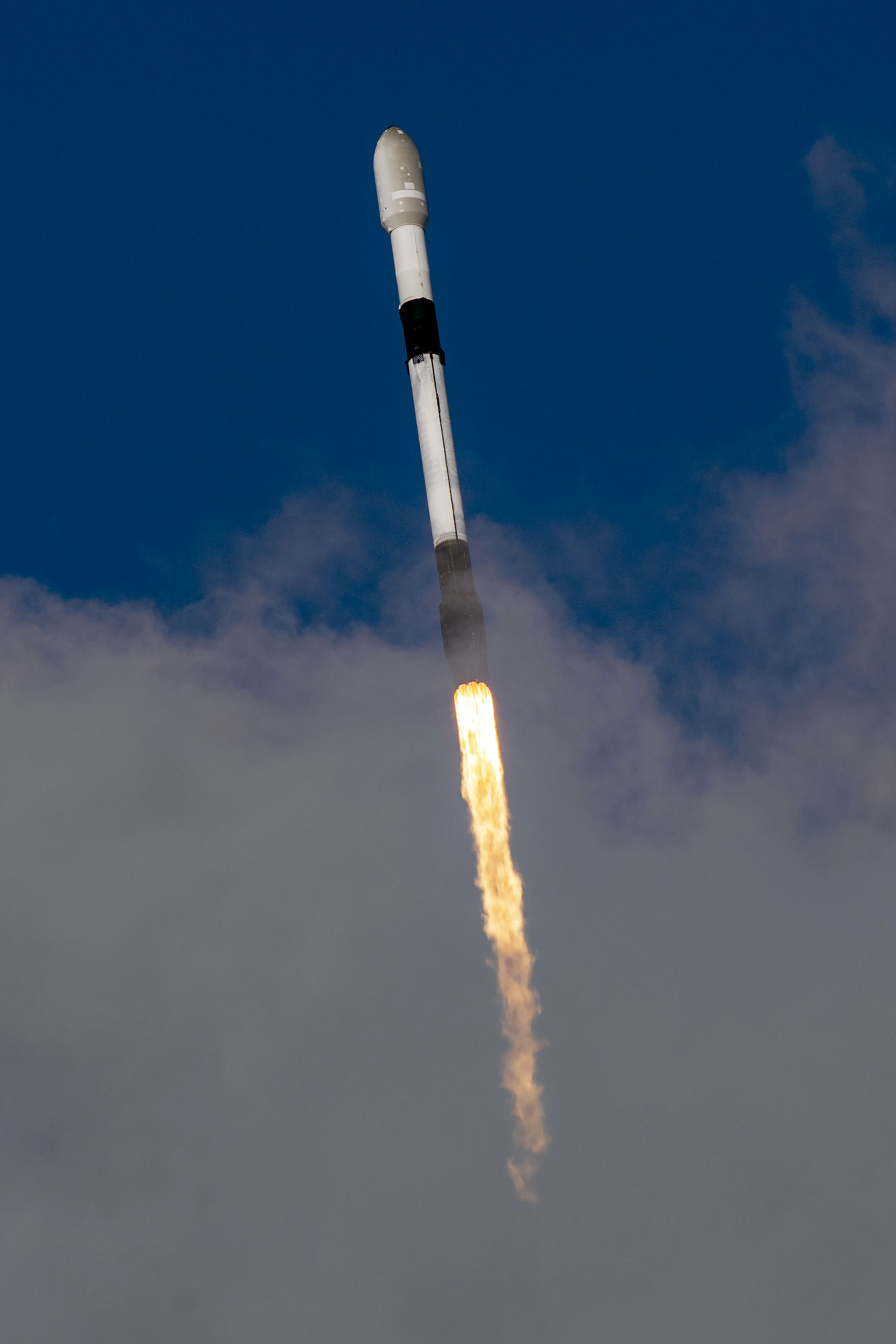
Falcon 9 Booster
The booster supporting the IM-1, Nova-C Odysseus mission was B1060-18; as the name implies, the booster had supported 17 previous missions. Following its landing, its designation changed to B1060-19.
| B1060’s previous missions | Launch Date (UTC) | Turn Around Time (Days) |
| GPS III SV03 | June 30, 2020 20:10 | N/A |
| Starlink V1.0 L11 | September 3, 2020 12:46 | 64.69 |
| Starlink V1.0 L14 | October 24, 2020 15:31 | 51.11 |
| Türksat-5A | January 8, 2021 02:15 | 75.45 |
| Starlink V1.0 L18 | February 4, 2021 06:19 | 27.17 |
| Starlink V1.0 L22 | March 24, 2021 08:28 | 48.09 |
| Starlink V1.0 L24 | April 29, 2021 03:44 | 38.50 |
| Transporter-2 | June 30, 2021 19:31 | 62.66 |
| Starlink Group 4-3 | December 2, 2021 23:12 | 155.15 |
| Starlink Group 4-6 | January 19, 2022 02:02 | 47.22 |
| Starlink Group 4-9 | March 3, 2022 14:35 | 43.52 |
| Starlink Group 4-14 | April 21, 2022 17:51 | 49.14 |
| Starlink Group 4-19 | June 17, 2022 16:09 | 56.93 |
| Galaxy 33 & 34 | October 8, 2022 23:05 | 113.29 |
| Transporter-6 | January 3, 2023 14:55 | 86.66 |
| Starlink Group 5-15 | July 16, 2023 03:50 | 193.54 |
| Starlink Group 6-18 | September 24, 2023 03:38 | 69.99 |
Following stage separation, the Falcon 9 conducted three burns. These burns allowed for a successful touch down of the booster on SpaceX’s Landing Zone 1 (LZ-1).
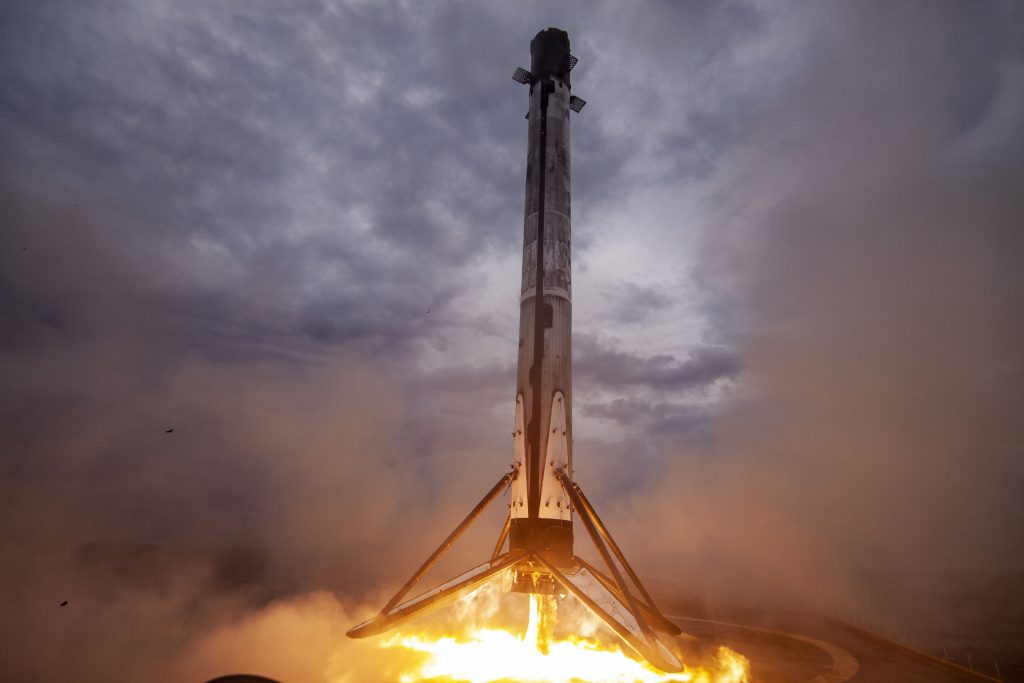
Falcon 9 Fairings
The Falcon 9’s fairing consists of two dissimilar reusable halves. The first half (the half that faces away from the transport erector) is called the active half, and houses the pneumatics for the separation system. The other fairing half is called the passive half. As the name implies, this half plays a purely passive role in the fairing separation process, as it relies on the pneumatics from the active half.
Both fairing halves are equipped with cold gas thrusters and a parafoil which are used to softly touch down the fairing half in the ocean. SpaceX used to attempt to catch the fairing halves, however, at the end of 2020 this program was canceled due to safety risks and a low success rate. On IM-1, SpaceX recovered the fairing halves from the water with its recovery vessel Bob.
In 2021, SpaceX started flying a new version of the Falcon 9 fairing. The new “upgraded” version has vents only at the top of each fairing half, by the gap between the halves, whereas the old version had vents placed spread equidistantly around the base of the fairing. Moving the vents decreases the chance of water getting into the fairing, making the probability of a successful scoop significantly higher.
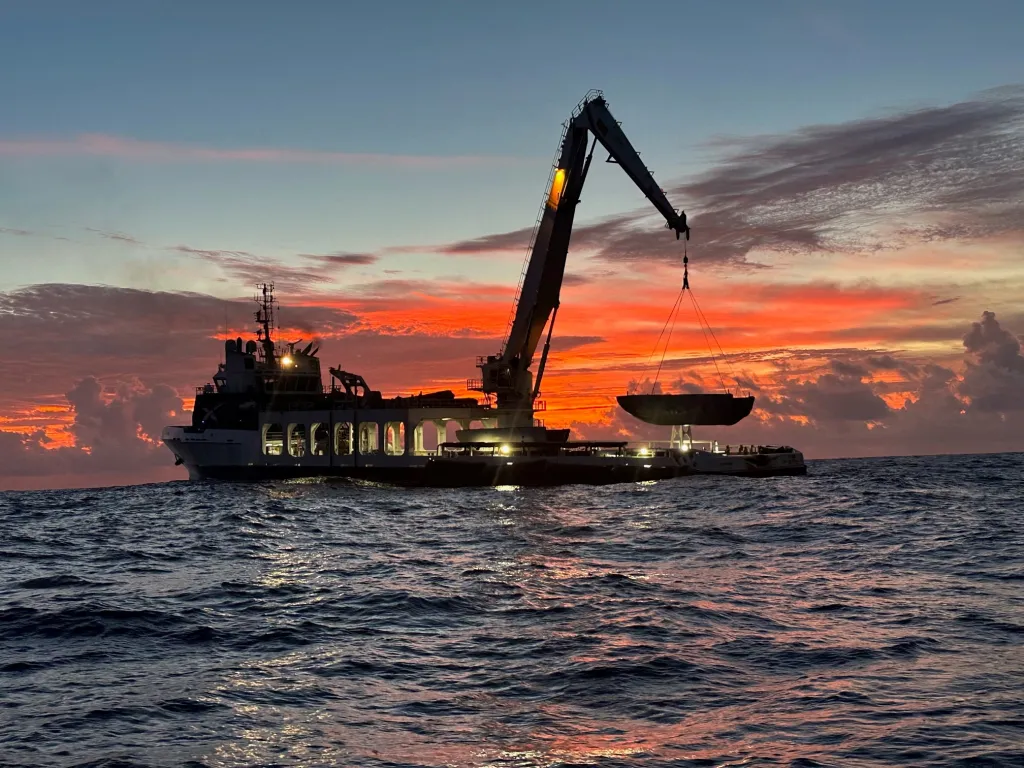
IM-1’s Countdown
All Times Approximate
| HR/MIN/SEC | EVENT |
|---|---|
| 00:38:00 | SpaceX Launch Director verifies go for propellant load |
| 00:35:00 | RP-1 (rocket grade kerosene) loading begins |
| 00:35:00 | 1st stage LOX (liquid oxygen) loading begins |
| 00:16:00 | 2nd stage LOX loading begins |
| 00:07:00 | Falcon 9 begins engine chill prior to launch |
| 00:01:00 | Command flight computer to begin final prelaunch checks |
| 00:01:00 | Propellant tank pressurization to flight pressure begins |
| 00:00:45 | SpaceX Launch Director verifies go for launch |
| 00:00:03 | Engine controller commands engine ignition sequence to start |
| 00:00:00 | Falcon 9 liftoff |
IM-1’s Launch, Landing, And Deployment
All Times Approximate
| HR/MIN/SEC | EVENT |
|---|---|
| 00:01:12 | Max Q (moment of peak mechanical stress on the rocket) |
| 00:02:14 | 1st stage main engine cutoff (MECO) |
| 00:02:17 | 1st and 2nd stages separate |
| 00:02:25 | 2nd stage engine starts |
| 00:02:30 | Boostback burn starts |
| 00:03:06 | Fairing deployment |
| 00:03:27 | Boostback burn Ends |
| 00:06:11 | 1st stage entry burn start |
| 00:06:22 | 1st stage entry burn ends |
| 00:07:17 | 1st stage landing burn start |
| 00:07:34 | 1st stage landing |
| 00:07:46 | 2nd stage engine cutoff (SECO-1) |
| 00:41:40 | 2nd stage engine starts (SES-2) |
| 00:42:33 | 2nd stage engine cutoff (SECO-2) |
| 00:48:24 | IM-1 deploys |




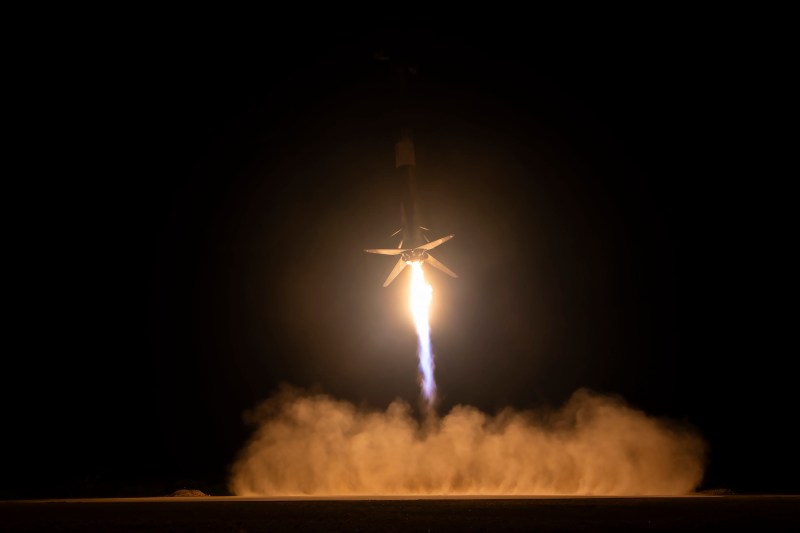
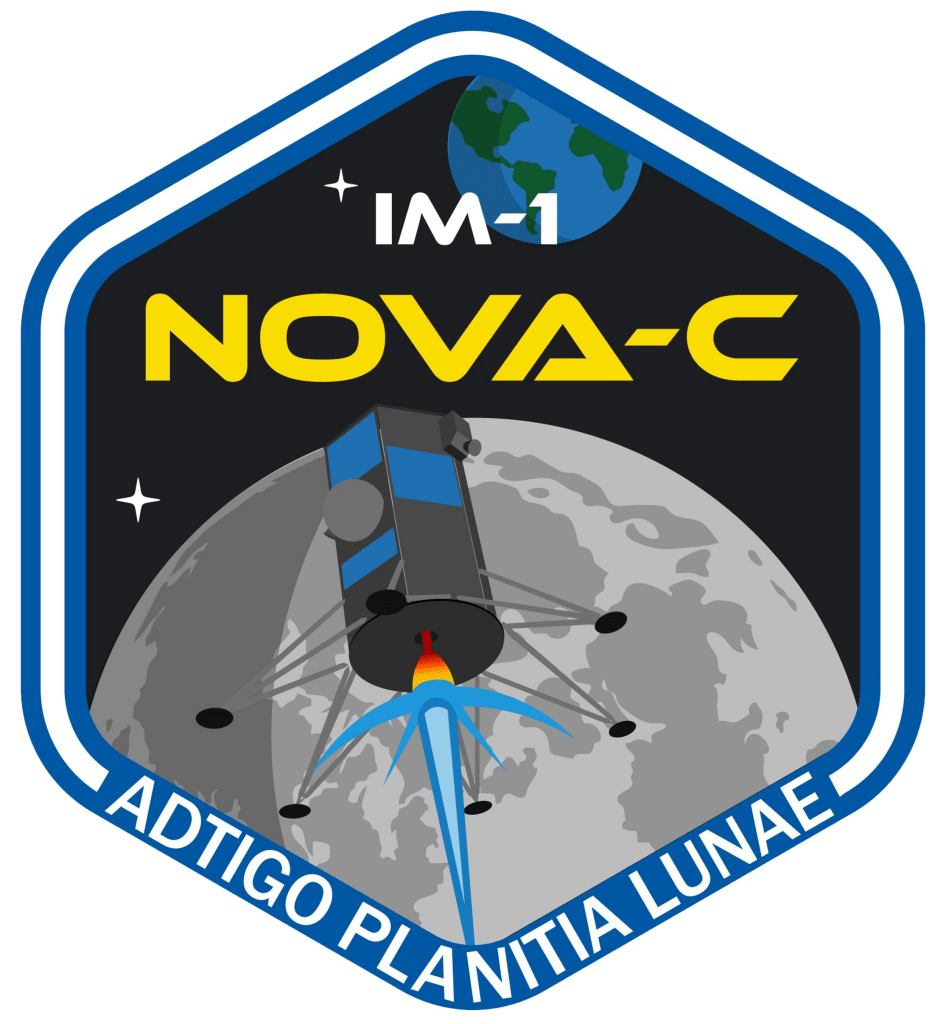

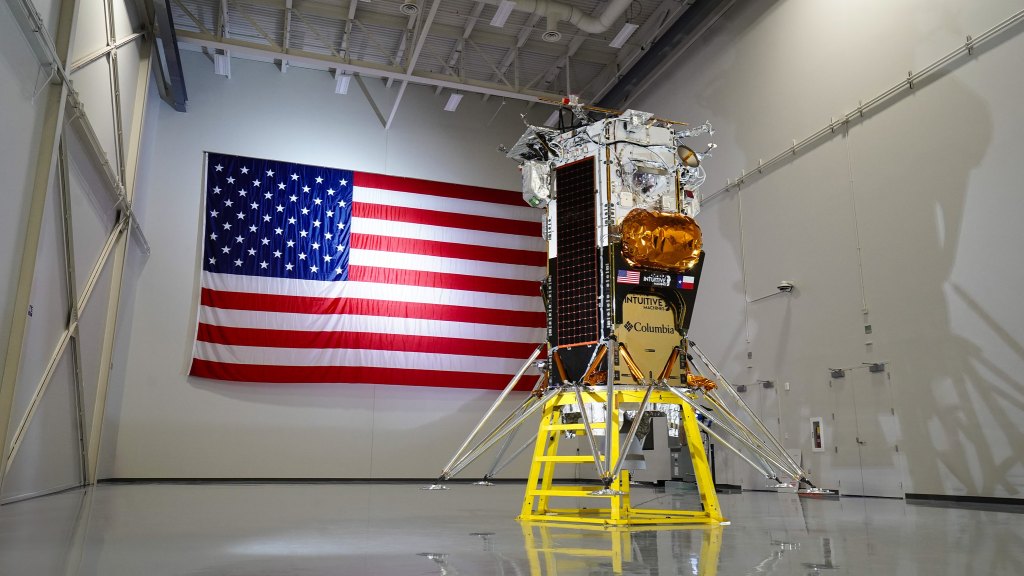

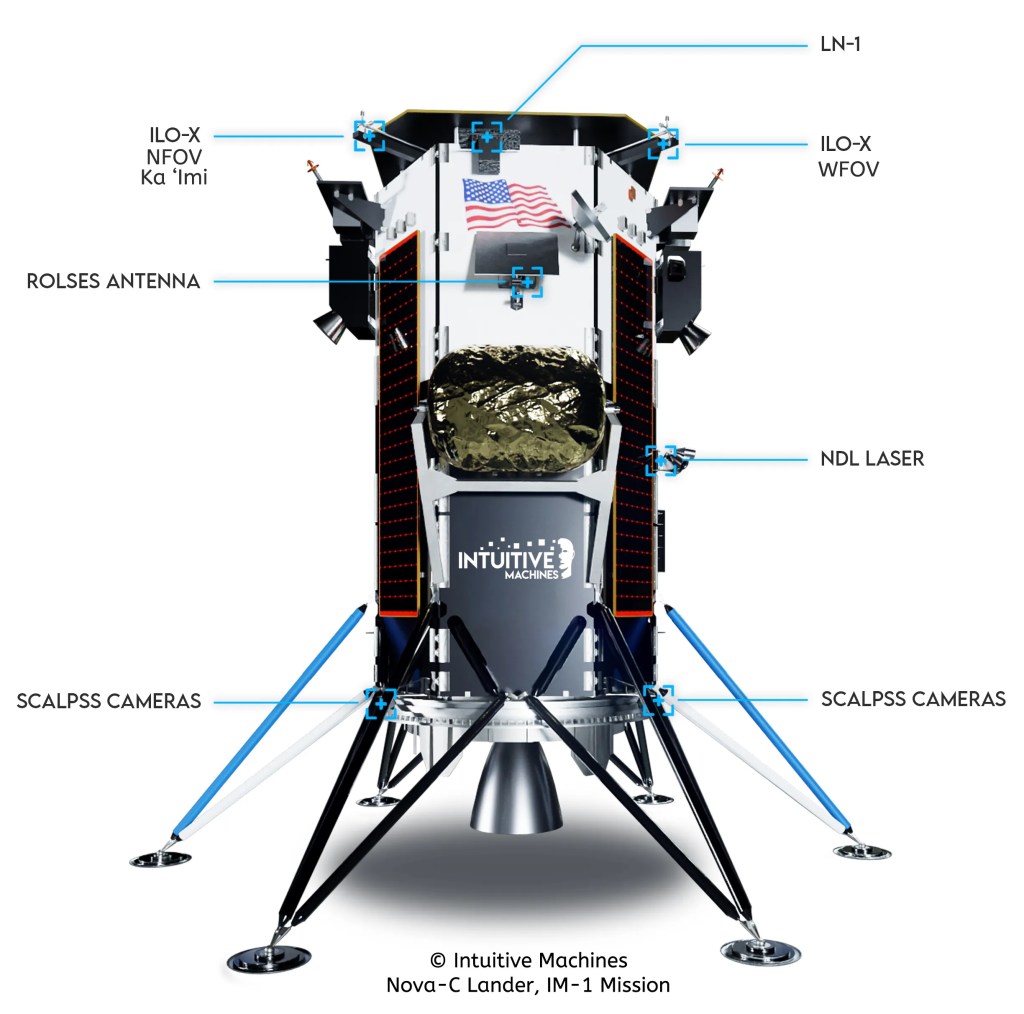
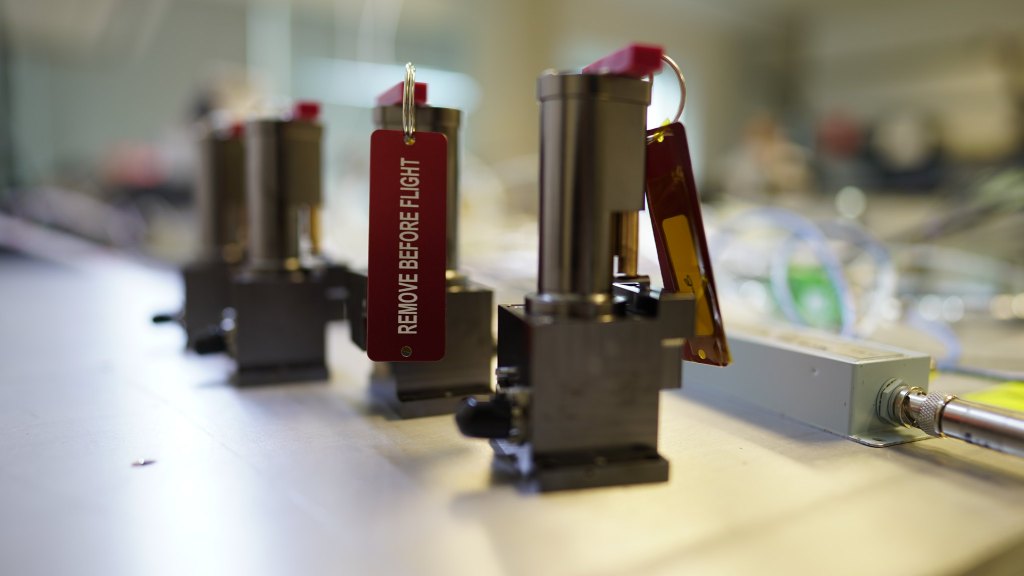
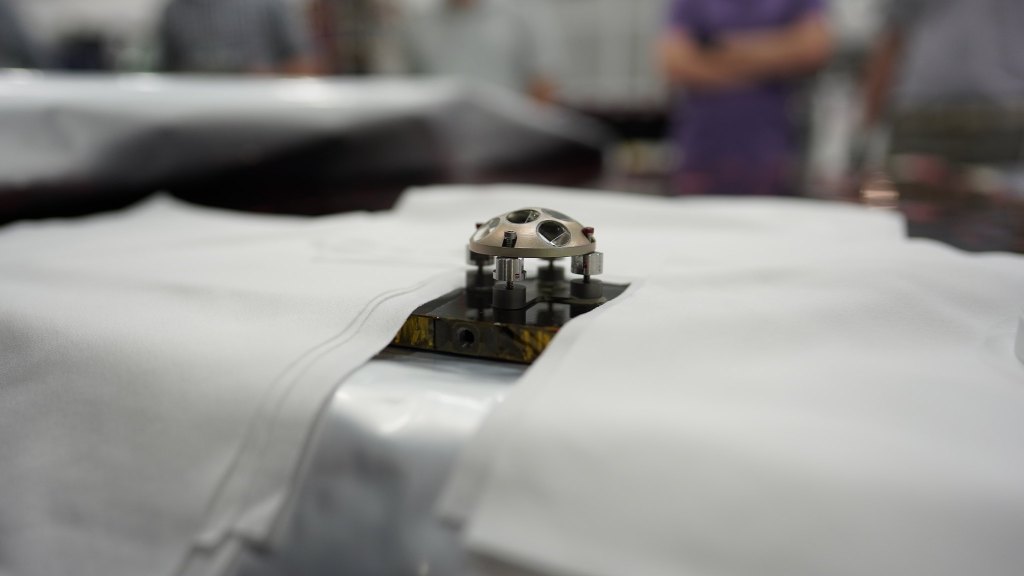

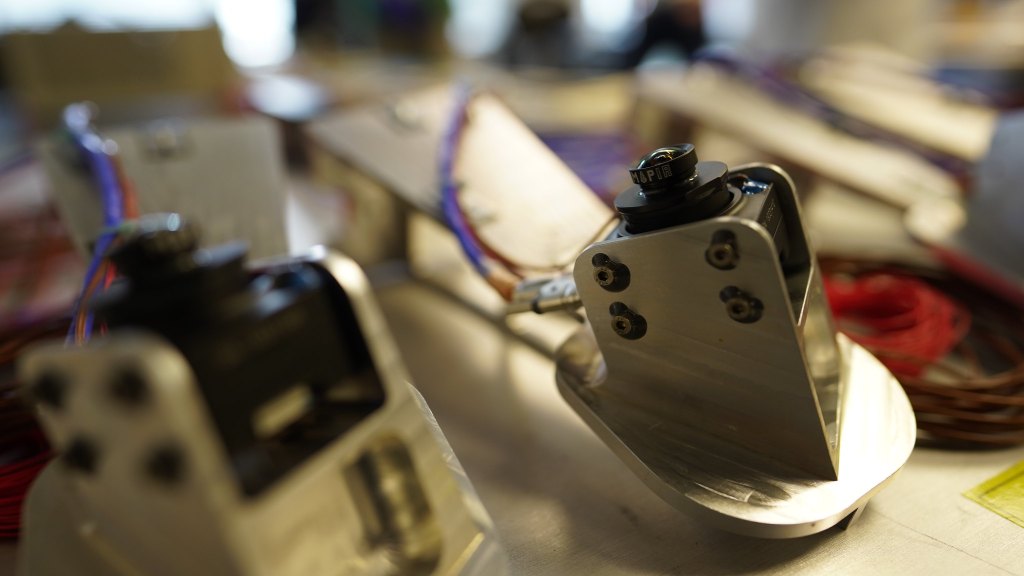



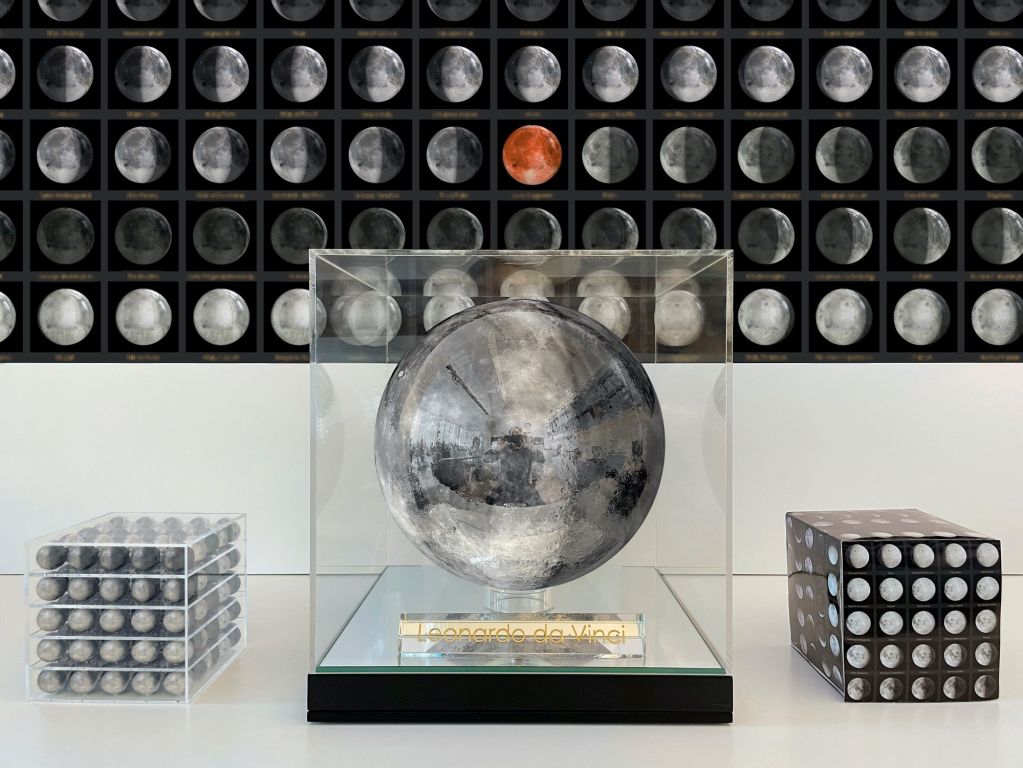
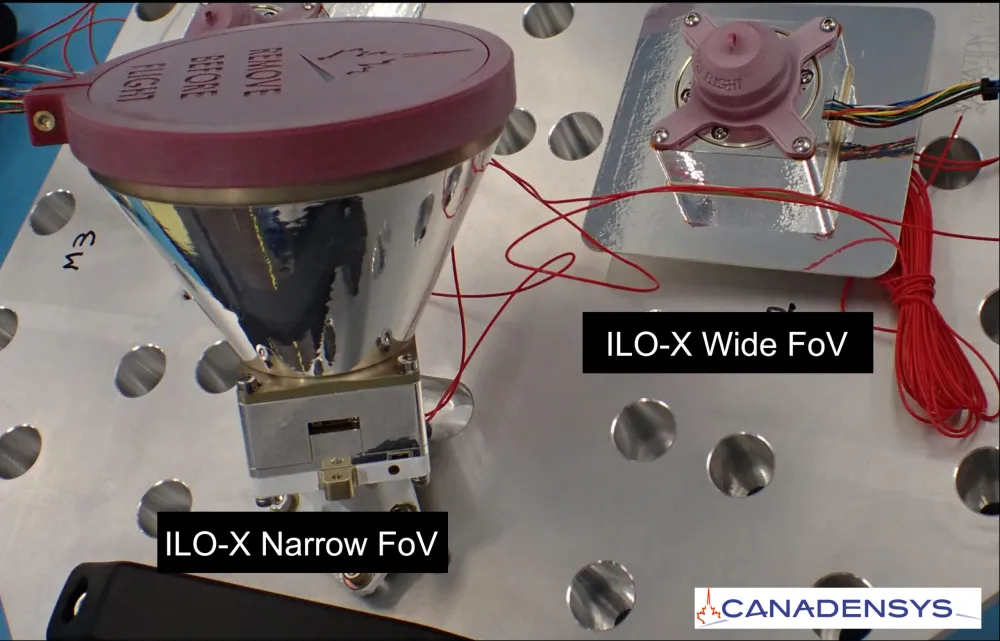
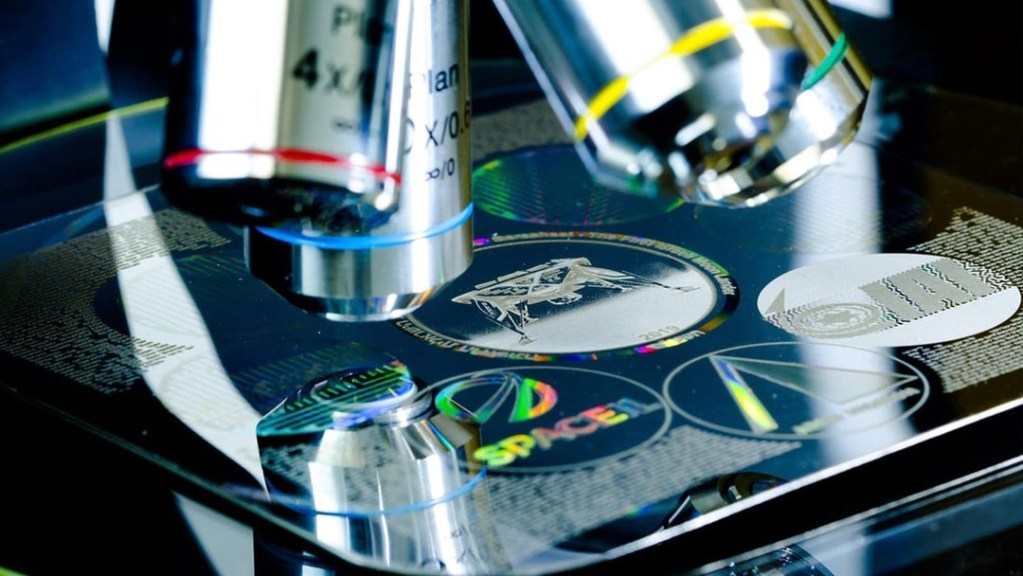
Very nice article. It was detailed and yet personable (“Odie”) with a wonderful step by step description of the mission, its contributors and its expected outcomes. Bravo and good luck.
Thank you for your kind words! I’m glad you enjoyed the read!
Yes, I agree with Dean, very well written.. good Job!!
Thank you, too! =)
Any idea when IM-2 is scheduled?
As of 2024-02-25, I see it scheduled for NET December 2024.